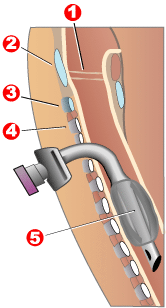
Photo from wikipedia
Many factors influence the choice of endotracheal (ET) tube size in adults, including the patient’s size, sex, reason for tube placement, anticipated duration of intubation, and preference of the anesthesiologist.… Click to show full abstract
Many factors influence the choice of endotracheal (ET) tube size in adults, including the patient’s size, sex, reason for tube placement, anticipated duration of intubation, and preference of the anesthesiologist. ET tube size should be selected to match the expected airway diameter and ventilator needs of the patient and, in general, larger ET tubes are used in presumptively larger tracheas. However, less thought is given to the long-term, potentially morbid complications such as tracheal stenosis that can arise from the use of larger ET tubes. Very few guidelines exist regarding the choice of ET size, and those that do are not evidence based, leading to considerable variability in the size of ET tubes used by different providers and institutions. This paper will examine the risks and benefits of the use of larger ET tubes and review the data regarding body characteristics and tracheal diameter, focusing on the relationship between ET tube size and tracheal stenosis.
Journal Title: International Anesthesiology Clinics
Year Published: 2017
Link to full text (if available)
Share on Social Media: Sign Up to like & get
recommendations!